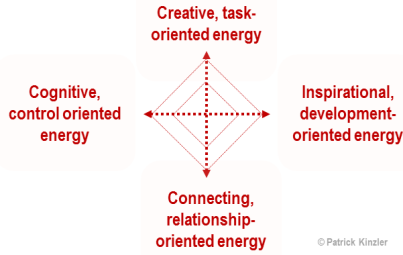Leadership Qualities
By experience and education everybody has developed a preferred (and well known) way to react to most situations. Thei preferred ways ist strongly interrelated with the driving mental models of person, one’s view on how good leadership looks like. For a lot of situations this way is helpful and functional.
“Unfortunately” the outside world does not always need what is easiest to offer. Sometimes a situation demands a different reaction and with applying the preferred reaction the results are poor.
Yet the ability of a leader to respond appropriately to different situations is there. Everybody can expand their possibilities to react and thereby be effective.
A proven framework that enables access to the different resources in a person (organization) is shown below. These essential leadership qualities go back on the typology of G. C. Jung and build the theoretical basis for most existing tests and tools in the market.
Depending of the model they have different names but in essence one can find the following four directions:
As the picture indicates the four essential energies are organized in polarities. Each person can find his current preference by identifying his position along the two continua.
Questions I use in order to support leaders expanding their response-ability are:
- In which situations could another than your preferred way be helpful?
- Are there typical situations after those you always ask yourself why the auto-pilot has taken over again?
- What would happen if you behave differently in these situations?
- How would this different behavior interact with your mental model of leadership? Does it fit in?
Answering this kind of questions creates the openness to the other ways of re-acting to situations.

